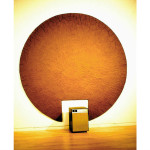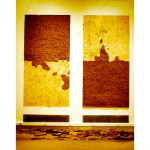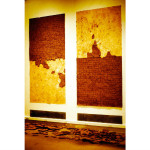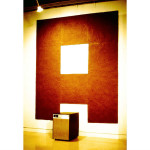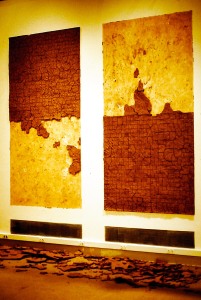How do you bring temporal site-specific installations into the sterile, hyper-regulated environment of a gallery? The suck series integrates formations of wet clay with dehumidifiers to trigger natural, dynamic processes. An internal metal armature can influence, to a point, what remains on the wall and how the piece will crack as it dries.
The gallery is the arena of choice for most in the art world. If you are in art school or want to engage with the traditional art crowd you need to show in a gallery. What is a site-specific environmental artist to do?
Artists, such as Richard Long, use spare straightforward documentation to bring their installations into the gallery. This documentation includes photographs, artifacts, and text-based descriptions. While I had followed this path as well, it always seemed a bit wanting and distant from the actual piece.
I wanted to see if I could tap into the actual environment of a gallery, a setting that actually strives to eliminate, or at least reduce, environmental factors and influences. Since art can be adversely affected by excessively high, low or changing levels of moisture in the air, most galleries regulate the relative humidity through elaborate humidifying/dehumidifying systems. It is this characteristic I wanted to play off of in my Suck series.
In the very first Suck installation (not shown) I applied a thick slab of wet clay directly to a sheet rock wall. As the dehumidifiers sucked the moisture out of the air, and thus the piece, the whole slab fell as one giant mass, taking some of the wall with it. It was one of the more violent-looking pieces I had ever done. In later works, I wanted to accentuate the natural drying process so I used an internal metal armature to hold the clay in place. I quickly learned I could control, to some degree, how the piece cracked and fell away from the wall.
How can an environmental installation artist bridge the divide between the natural world and the hyper-regulated gallery setting? Richard Long models one approach. Here are some other approaches.
- Brian Collier’s creates museum-like installations that meld science and art to explore environmental issues.
- Ingrid Koivukangas couples multimedia platforms with her naturalist’s sensibility in her gallery-based shows.
- Steve Peters creates elaborate soundscapes to bring nature indoors.
- Mara Adamitz Scrupe is an interdisciplinary artist who has recreated natural systems in the gallery.
- Anne-Katrin Spiess mixes rituals and performances in her environmentally based gallery shows.
From their respective portfolios, select a characteristic show for each artist and create e-gallery tour. Step through the slides of each show with the brief description the artist provides. Have students rate on a scale of 1-6 (1 is the favorite) the different approaches. Tally and analyze the results as a class. Have students discuss why they felt one approach was more engaging than the others.

